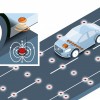Nearly every hybrid and electric car on the road relies on
neodymium magnets to power their motors and batteries. However, magnets actually play an even bigger role in drivers' lives in self-driving cars. With hype rising over self-driving vehicles in recent years, many are wondering whether this will ever actually be feasible.
For instance,
Volvo, known for innovation, developed an innovative venture that leverages magnets for autonomous driving. While Volvo may be one of the smaller auto brands in the world, it has made some significant strides in the realm of self-driving vehicles, especially with cars that can park themselves. The company aimed to design a vehicle that runs on magnets placed under the road.
Turning a dream into a reality
There are many challenges in completely autonomous vehicles. For example, NY Daily News pointed out that GPS or camera-based systems
cannot always manage certain conditions - such as fog, poor weather, complicated traffic or tunnels - and radar sensors are costly and cumbersome.
Volvo's research suggests that the simpler solution could lie in magnets. Essentially, the automaker has proposed that an autonomous vehicle could work if a series of
disc magnets were placed underneath the surface of the road, creating an invisible railway that would pull the car along. While the existing hardware would remain in the vehicle, these road magnets would add some reassurance and helpful guidance to a self-driving car or truck by ensuring accurate and reliable positioning.
To determine if this solution would be effective, Volvo constructed a 100-meter track with round 1.5-inch wide magnets at the company's test facility in Sweden. Then, they implemented magnetic field detectors in a prototype car. These experiments were funded by the Swedish Transport Administration, which Gizmag reported
has an interest in the technology. Jonas Ekmark, preventative safety leader at Volvo, revealed that the company has already tested this technology at a range of different speeds to promising results.
"Our experience so far is that ferrite magnets are an efficient, reliable and relatively cheap solution, both when it comes to the infrastructure and on-board sensor technology. The next step is to conduct tests in real-life traffic," Ekmark stated, according to NY Daily News.
A multitude of benefits
There are many ways this technology could prove valuable beyond ensuring that vehicles don't run off the road. Gizmag noted that Volvo asserts this solution could also facilitate improved road maintenance as the magnetic roadways would enable narrowed lanes. Not only that, but the magnetic system could also help to minimize damage to snow-covered objects on the part of road maintenance crews in winter.
Road magnets are a viable solution because they are not impacted by weather or physical obstacles. While this may sound like a significant and burdensome transformation, Ekmark emphasized that it's possible without making major changes to the present infrastructure. According to Digital Trends, Volvo maintains that the magnetic setup would be
relatively inexpensive to construct, but it remains to be seen whether the undertaking is realistic.
"The test results are very interesting, especially when adding the potential for improved safety as well the advantages for the development of self-driving vehicles," said Claes Tingvall, traffic safety director at the Swedish Transport Administration, as quoted by Gizmag. "A large-scale implementation of road magnets could very well be part of Sweden's aim to pioneer technology that contributes to sustainable mobility."
What This Discovery Means and More with Apex Magnets
We are constantly on the lookout for new magnet discoveries. For more updates on autonomous vehicles, browse our neodymium magnet information and magnet facts sections of the blog, or subscribe to our newsletter today. 
